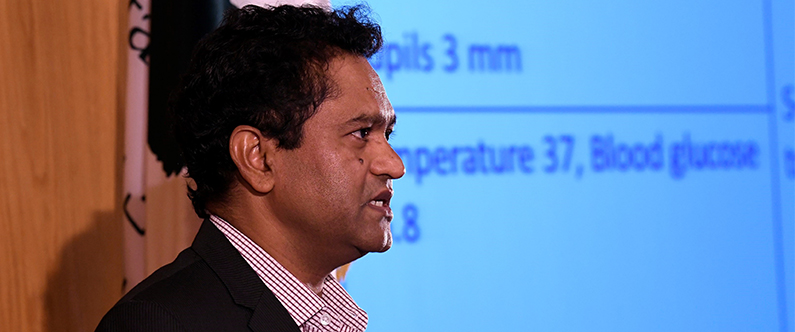Pediatric care and reconstructive surgery discussed at WCM-Q Grand Rounds
 Dr. Ashok Aralihond said children should not simply be viewed as "little adults" as their physiology is different.
Dr. Ashok Aralihond said children should not simply be viewed as "little adults" as their physiology is different.
Two expert speakers gave presentations on critical care pediatrics and craniofacial reconstructive surgery at Weill Cornell Medicine-Qatar’s Grand Rounds lecture series.
Dr. Ashok Aralihond, attending physician in the pediatric emergency department at Sidra Medicine and assistant professor of clinical pediatrics at WCM-Q, gave a lecture explaining the evaluation and stabilization of acutely ill children in the emergency room.
Speaking to an audience of physicians, nurses, students, educators and other healthcare professionals, Dr. Aralihond stressed that children must not be viewed as ‘little adults’ because their anatomy, physiology and pathology are all very different. Physicians treating children in emergency situations should follow a systematic, structured approach, he explained.
“When we see the child in the emergency department as a pediatrician or any other physician, it is important to focus on the primary assessment and identify the problems, and then to resuscitate. Then we go to secondary assessment, which is basically a focused history, the next step is more investigations and examinations, which allow us to give appropriate emergency treatment, after which we move to stabilization and transfer to definitive care.”
Dr. Graeme E. Glass, attending plastic and craniofacial surgeon at Sidra Medicine and assistant professor of clinical (plastic) surgery at WCM-Q, gave a lecture entitled ‘Innovations in Craniofacial Reconstructive Surgery’ in which he explained various abnormalities in the development of the skull in children and the interventions used to treat them. These included craniosynostosis, in which the plates of the skull fuse too soon or abnormally, which often requires surgical treatment, and plagiocephaly, in which a flat spot or other unevenness develops, and which can be treated with a custom-designed helmet.
Dr. Glass said: “In the most severe cases [of plagiocephaly], we can use a molding helmet, which are made by a company in the US. Thanks to a great innovation we don’t actually need a CT scan to get these custom-designed helmets – all we need is a 3-D picture. So, we take a 3-D picture of the patient’s head, which is uploaded to a server in the US, they make the helmets for us and post them back within three weeks.”
Dr. Glass went on to outline the influence of craniosynostosis on intercranial pressure and also explained several types of craniofacial deformities and the frontofacial surgeries deployed to correct them. Both lectures were accredited locally by the Qatar Council for Healthcare Practitioners-Accreditation Department (QCHP-AD) and internationally by the Accreditation Council for Continuing Medical Education (ACCME).